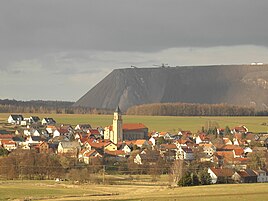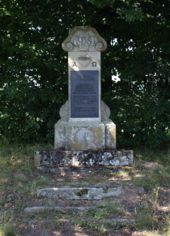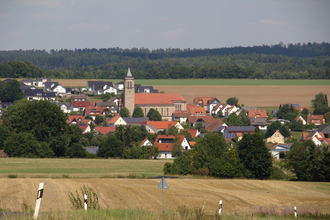Rommerz
|
Rommerz
municipality Neuhof
Coordinates: 50 ° 27 ′ 2 ″ N , 9 ° 34 ′ 40 ″ E
|
|
|---|---|
| Height : | 286 m above sea level NHN |
| Area : | 6.35 km² |
| Residents : | 1637 (Dec. 31, 2013) |
| Population density : | 258 inhabitants / km² |
| Incorporation : | August 1, 1972 |
| Postal code : | 36119 |
| Area code : | 06655 |
|
View of Rommerz with the Monte Kali von Neuhof and the Kath. Church of the Assumption of Mary
|
|
Rommerz is a district of the Neuhof municipality in the Fulda district in East Hesse .
Geographical location
Rommerz lies in the southern district of Fulda in the Kemmetetal ; the stream of the same name flows through the village. The district town of Fulda is located about 20 km northeast of Rommerz. The village borders on the eastern foothills of the Vogelsberg . The front foothills of the Rhön are about 10 km east of Rommerz. To the north-east of the village is the approximately 120 meter high spoil dump of the K + S potash works Neuhof - Ellers, which is also called "Kaliberg" or " Monte Kali " in colloquial language . The heap, which now stretches almost a kilometer in length, is characteristic of the backdrop of Rommerz and the entire area. Rommerz borders in the north on the Rommerzer forest, a large contiguous forest area, and in the south on the municipality of Flieden. West of Rommerz the district is Hauswurz .
history
Beginnings of settlements and first mention
There is very little evidence of the beginnings of settlement in the Rommerz district. The first settler is said to have settled in Rommerz around 1000. He was called Hruotmunt (= glorious protector). The original farm and the surrounding village were named "Rumundes" after him. With this name Rommerz appears for the first time in a document in 1165 in a property register of the Fulda provost Michaelsberg. In 1330 were under the Fulda prince Heinrich VI. von Hohenberg pledged the Fulda goods and people from the village of "Rumundes" together with other surrounding villages (Opperz, Schweben and the Remerz settlement) to the Küchenmeister family, which appears in several documents from the Fulda Monastery. The Remerz settlement mentioned in the pledge was located on the banks of the Kemmete, probably at the end of today's forest road. A second settlement, which was lost in the course of history, was located within the Rommerz district: "Wanhütten" in the central Kemmetetal. It appears in a document in 1353.
The 20th century
In the period after the First World War , not only the economic but also the cultural upswing found its way into Rommerz. Several clubs such as sports club, volunteer fire brigade , carrier pigeon club and carnival club were founded. Special infrastructural events were the laying of the water pipes in 1911, the connection of the Rommerz community to the electricity network in 1921 and the construction of the local sewerage system from 1928.
In 1936, the Rommerz-based sisters of the Vincentian Order had to leave their sister house on the "Fuchsberg" because a camp for the female labor service was set up here. On Easter Sunday 1945, Rommerz was occupied by American troops.
After the end of the Second World War , infrastructure measures were then implemented in Rommerz. For example, new roads and thus new settlement areas were created. The local school received an extension in 1950; in 1963 a fire station was built. A new deep well was drilled for the drinking water supply in 1964, in 1966 the Kemmetestadion with soccer field, a training field and several athletics facilities was inaugurated, and in 1969 a new elevated tank was added. Several craft businesses also started production in Rommerz. In 1972 a community center was inaugurated. In the 1970s, a sports home at the Kemmetestadion and a new kindergarten building were also built, the old kindergarten at Fuchsberg 22 (today the seminar house) was sold by the community because it was due for construction. A gymnasium and sports hall was built in the early 1980s.
Territorial reform
As part of the regional reform in Hesse , Rommerz was incorporated into Neuhof by state law with effect from August 1, 1972.
Population development
A cattle list from 1510 provides information for the first time about the population of Rommerz. A total of 11 cattle farmers are named. However, these are only the feudal people of the prince, not those of the provosts and the nobility. The Turkish tax list from 1605 lists 44 taxpayers. In 1656 there were 27 families, around 120 inhabitants. In the Salbuch of 1714 there are 33 owners. In 1743 46 houses are registered. A concrete figure about the total number of inhabitants, however, is available for the first time in 1773. Here we are talking about 286 inhabitants. Several official documents from the period between the 18th and 20th centuries show that at that time there was also greater poverty in Rommerz. For this reason, 118 inhabitants immigrated to the USA in the years 1829 to 1855 alone. It did not improve until the beginning of the 20th century. The construction of the potash works in Neuhof, which began in 1906, was particularly important here. Numerous Rommerz villagers also found work here. With the increasing economic success of potash mining, Rommerz was also able to record some immigration. In 1924 Rommerz already had 857 inhabitants. This number rose particularly sharply in the years after World War II . In 1946 alone, around 170 displaced persons came to Rommerz, mostly from Falkenau in the Egerland. In 1970, 1,573 people lived in Rommerz, which was divided into 296 houses. The number continued to rise, to 1,657 inhabitants by 1982. In the following years the 1,800 population mark was just reached; in 2013, however, it fell back to 1,638. Due to the current births and deaths rate, the trend is increasing.
religion
Religious affiliation
Of the 1,638 inhabitants (as of June 2013) around 1,300 belong to the Catholic denomination. The local Catholic parish and the parish church are assigned the name of the Assumption of Mary . It belongs to the diocese of Fulda and is part of the dean's office Neuhof-Großenlüder in the pastoral association Heilig Geist Kalbach-Neuhof.
Since 2005, due to the lack of priests on the one hand and the pastoral process on the other, the parish has been supervised and administered by the pastor of the parish of St. Michael in the main town of Neuhof. Pastor Dagobert Vonderau has been the responsible parish administrator since August 2012. He is supported in his work by a chaplain and a parish officer.
Evangelical parish
The Protestant parish has no church in Rommerz, the services were held in the Rommerzer school until 1973. Rommerz has had its own evangelical parish hall at Forststrasse 1 in Kreuzdorf since 1973. For worship, the believers drive to Neuhof (Albert Schweizer Straße 5) or to Flieden (Hinzergasse 8), there is a Protestant church there.
Catholic Church
Beginnings of pastoral care
Until the middle of the 16th century, the residents of Rommerz and the surrounding villages and settlements had to go to the parish of Flieden to attend church services. There the children were baptized and the dead were buried. It was not until the Neuhof parish was founded around 1560 that Rommerz was assigned to a new parish. At the time, Rommerz did not yet have a church.
Between 1735 and 1737 a local carpenter's journeyman built the first small half-timbered chapel. This stood in the center of the village, on the current intersection of the main roads to Neuhof, Flieden and Hauswurz. Wooden figures from that time still existing today indicate that the chapel was dedicated to the Fourteen Holy Helpers. Regular services did not take place in Rommerz at first. To do this, the villagers had to continue to go to Neuhof. The small chapel was later expanded.
From 1759 onwards, several stationaries - most of them belonged to the Franciscan order - were active as pastors in Rommerz for a limited time. From the first half of the 19th century, the pastors and chaplains from Neuhof were responsible for worship and pastoral care in Rommerz. There was no pastor of its own until the Rommerz parish was founded at the beginning of the 20th century.
The first church
In 1862, the then mayor Lorenz Heurich turned to the Episcopal Authority in Fulda and pointed out the untenable conditions during the service in the small chapel. At that time, Rommerz already had around 600 inhabitants, so there was a dense crowd in the chapel. The Episcopal Authority agreed to the construction of a new and larger church. The first thing to do was to clarify the financing issue. The cost estimate was 4,200 guilders. The Rommerz community and the electoral government each contributed 500 guilders. The rest was financed through a loan and the increased use of personal contributions. A building site opposite the primary school at the intersection of Hauswurzer Strasse and Maigrabenstrasse was chosen as the plot of land. The foundation stone was laid on May 27, 1865, and the masonry work was completed on October 5 of the same year. The church was a fairly simple rectangular building with arched windows and a gable roof. The architect is unknown. The new church was consecrated on September 25, 1866 in honor of Our Lady. Interior furnishings such as the pulpit, altar, pictures of the Stations of the Cross and organ were only acquired in the following years or accepted as donations. The baroque altar, for example, was a gift from the Fritzlar Ursuline Monastery and was picked up from there by horse and cart.
As it turned out later, the church was designed too small from the start: soon there was a lack of space again. This is not least due to the rapid increase in the number of residents. Therefore, immediately after the First World War, plans began to expand the church. For various practical reasons, however, these considerations have not been put into practice. Instead, plans were made for a completely new building. After its completion, the church was initially unused from 1934 until it was finally demolished in 1963. The stones were used to build the new church in Fulda-Oberrode.
Parish establishment
On August 1, 1909, Rommerz was first raised to a parish curate by the Fulda Bishop Joseph Damian Schmitt. In the following years, several curates were responsible for pastoral care until Rommerz was elevated to a parish on December 1, 1920.
The following pastors have been active in Rommerz since the parish was founded:
| Pastor | Period |
|---|---|
| Andreas Führ | 1921-1930 |
| Julius Braun | 1930-1933 |
| Johannes Rossmann | 1934-1963 |
| Erwin Sturm | 1963-2003 |
After Pastor Erwin Sturm had headed the parish Rommerz for 40 years as a pastor, he had to retire in 2003 for health reasons.
Parish today
Due to the increasing shortage of priests on the one hand and the pastoral process initiated by Bishop Heinz Josef Algermissen for the diocese of Fulda on the other hand, the parish of Rommerz has not been filled with its own pastor since then. Instead, a parish community was formed with the parish of St. Michael in Neuhof and it was incorporated into a newly created pastoral association Kalbach-Neuhof. The parish of Rommerz was retained, however, in its parish status. Only the occupation of a pastor's position was deleted. The pastor of the Magdlos parish, Heinrich Matthias Schild, temporarily took over the management and pastoral care of the Rommerz parish from 2003 to 2005.
The following pastors have been responsible for Rommerz since it became part of the Neuhof parish:
| Pastor | Period |
|---|---|
| Bernhard ax | 2005–2012 |
| Dagobert Vonderau | since 2012 |
Since 2008, the parish church of St. Mariae Himmelfahrt has been fundamentally renewed both inside and out and reopened in April 2013. In this context, the church was painted in color by the Frankfurt artist Michael Mohr .
The renowned Otto bell foundry from Hemelingen repeatedly supplied bells for the Church of St. Mariae Himmelfahrt . In 1923 it delivered a bell, which was confiscated and melted down during World War II. After the war, Otto cast a total of five new bronze bells for St. Mariae Himmelfahrt in 1949 and 1967.
politics
The village of Rommerz was a politically independent municipality until it was incorporated into the municipality of Neuhof on August 1, 1972 as part of the regional reform .
| mayor | Period |
|---|---|
| Lorenz Heurich | 1852-1891 |
| Damian Heurich | 1891-1897 |
| Aegil Möller | 1897-1900 |
| Damian Gardener | 1900-1908 |
| Damian Jahn | 1910-1919 |
| August Weber | 1919-1923 |
| Franz-Josef Heil | 1923-1932 |
| Boniface Kess | 1932-1933 |
| Karl Gutberlet | 1933-1934 |
| Ferdinand Föller | 1934-1946 |
| Josef Atzert | 1946-1965 |
| Willi Herr | 1965-1972 |
| Mayor | Period |
|---|---|
| Helmut Rübsam (CDU) | 1972-1985 |
| Werner Spitznagel (CDU) | 1985-1989 |
| Horst Michel (SPD) | 1989-2006 |
| Norbert Schleicher (CDU) | 2006-2016 |
| Jürgen Auerbach (CDU) | 2016 until today |
Economy and Infrastructure
traffic
Landesstrasse 3181 (Neuhof– Grebenhain ) and Kreisstrasse 96 (Flieden – Rommerz) intersect in Rommerz. The Autobahn 66 can be reached via the junctions Flieden, Neuhof-Süd and Neuhof-Nord in 4 and 5 km respectively. Regional train stations are in Neuhof and Flieden. The next IC and ICE train station is Fulda .
education
Rommerz has its own elementary school , the "Monte Kali School" and a kindergarten , which is run by the Catholic parish.
literature
Erwin Sturm , festival magazine 50 Years Parish Church of the Assumption , 1982.
Web links
- Internet presence of the Neuhof community
- Rommerz. Info. In: www.rommerz.de. Private website
- Rommerz. Local history, information. In: www.heimatverein-rommerz.de. Homeland and history association Rommerz eV
- Rommerz, District of Fulda. Historical local dictionary for Hessen. In: Landesgeschichtliches Informationssystem Hessen (LAGIS).
Individual evidence
- ^ Rommerz, District of Fulda. Historical local dictionary for Hessen. (As of September 3, 2015). In: Landesgeschichtliches Informationssystem Hessen (LAGIS).
- ↑ Population statistics of the Fulda district (PDF) accessed in September 2015.
- ↑ Law on the reorganization of the districts of Fulda and Hünfeld and the city of Fulda (GVBl. II 330-14) of July 11, 1972 . In: The Hessian Minister of the Interior (ed.): Law and Ordinance Gazette for the State of Hesse . 1972 No. 17 , p. 220 , § 12 ( online at the information system of the Hessian state parliament [PDF; 1,2 MB ]).
- ^ Federal Statistical Office (ed.): Historical municipality directory for the Federal Republic of Germany. Name, border and key number changes in municipalities, counties and administrative districts from May 27, 1970 to December 31, 1982 . W. Kohlhammer, Stuttgart / Mainz 1983, ISBN 3-17-003263-1 , p. 395 .
- ↑ Innetseite of the parish
- ↑ Rommerzer church reopened . In: Osthessen.tv
- ↑ Götz J. Pfeiffer: The wall paintings by Michael Mohr in St. Mariae Himmelfahrt zu Rommerz. (PDF) In: Old and New Art, Vol. 48, 2014, pp. 116–120.
- ^ Gerhard Reinhold: Otto bells. Family and company history of the Otto bell foundry dynasty . Self-published, Essen 2019, ISBN 978-3-00-063109-2 , p. 588, here in particular pp. 525, 546, 562 .
- ↑ Gerhard Reinhold: Church bells - Christian world cultural heritage, illustrated using the example of the bell founder Otto, Hemelingen / Bremen . Nijmegen / NL 2019, p. 487, 503, 515 , urn : nbn: nl: ui: 22-2066 / 204770 (dissertation at Radboud University Nijmegen).




